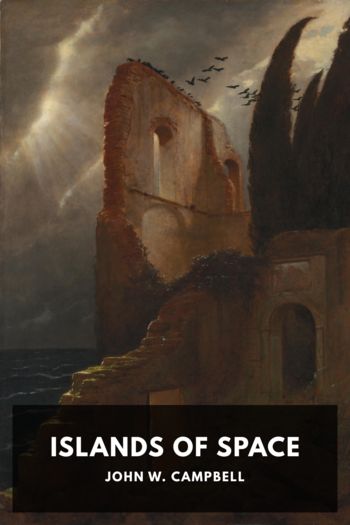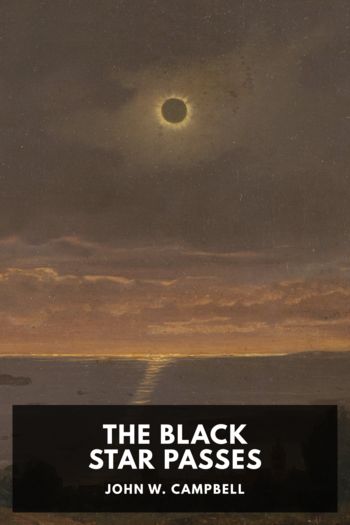Islands of Space - John W. Campbell (pdf to ebook reader TXT) 📗

- Author: John W. Campbell
Book online «Islands of Space - John W. Campbell (pdf to ebook reader TXT) 📗». Author John W. Campbell
They continued over the broad sweep of the level, crystalline plain as the bleak rock disappeared behind them. This world was about ten thousand miles in diameter, and its surface gravity about a quarter greater than that of Earth.
On and on they swept, swinging over the planet at an altitude of less than a thousand feet, viewing the unutterably desolate scene of the cold, dead world.
Then, ahead of them loomed a bleak, dark mass of rock again. They had crossed the frozen ocean and were coming to land again—a land no more solid than the sea.
Everywhere lay the deep drifts of snow, and here and there, through valleys, ran the streams of bright blue.
“Look!” cried Morey in sudden surprise. Far ahead and to their left loomed a strange formation of jutting vertical columns, covered with the white burden of snow. Arcot turned a powerful searchlight on it, and it stood out brightly against the vast snowfield. It was a dead, frozen city.
As they looked at it, Arcot turned the ship and headed for it without a word.
It was hard to realize the enormity of the catastrophe that had brought a cold, bleak death to the population of this world—death to an intelligent race.
Arcot finally spoke. “I’ll land the ship. I think it will be safe for us all to leave. Get out the suits and make sure all the tanks are charged and the heaters working. It will be colder here than in space. Out there, we were only cooled by radiation, but those streams are probably liquid nitrogen, oxygen, and argon, and there’s a slight atmosphere of hydrogen, helium and neon cooled to about fifty degrees Absolute. We’ll be cooled by conduction and convection.”
As the others got the suits ready, he lowered the ship gently to the snowy ground. It sank into nearly ten feet of snow. He turned on the powerful searchlight, and swept it around the ship. Under the warm beams, the frozen gasses evaporated, and in a few moments he had cleared the area around the ship.
Morey and the others came back with their suits. Arcot donned his, and adjusted his weight to ten pounds with the molecular power unit.
A short time later, they stepped out of the airlock onto the ice field of the frozen world. High above them glowed the dim, blue-white disc of the tiny sun, looking like little more than a bright star.
Adjusting the controls on the suits, the four men lifted into the tenuous air and headed toward the city, moving easily about ten feet above the frozen wastes of the snow field.
“The thing I don’t understand,” Morey said as they shot toward the city, “is why this planet is here at all. The intense radiation from the sun when it went supernova should have vaporized it!”
Arcot pointed toward a tall, oddly-shaped antenna that rose from the highest building of the city. “There’s your answer. That antenna is similar to those we found on the planets of the Black Star; it’s a heat screen. They probably had such antennas all over the planet.
“Unfortunately, the screen’s efficiency goes up as the fourth power of the temperature. It could keep out the terrific heat of a supernova, but couldn’t keep in the heat of the planet after the supernova had died. The planet was too cool to make the screen work efficiently!”
At last they came to the outskirts of the dead city. The vertical walls of the buildings were free of snow, and they could see the blank, staring eyes of the windows, and within, the bleak, empty rooms. They swept on through the frozen streets until they came to one huge building in the center. The doors of bronze had been closed, and through the windows they could see that the room had been piled high with some sort of insulating material, evidently used as a last-ditch attempt to keep out the freezing cold.
“Shall we break in?” asked Arcot.
“We may as well,” Morey’s voice answered over the radio. “There may be some records we could take back to Earth and have deciphered. In a time like this, I imagine they would leave some records, hoping that some race might come and find them.”
They worked with molecular ray pistols for fifteen minutes tearing a way through. It was slow work because they had to use the heat ray pistols to supply the necessary energy for the molecular motion.
When they finally broke through, they found they had entered on the second floor; the deep snow had buried the first. Before them stretched a long, richly decorated hall, painted with great colored murals.
The paintings displayed a people dressed in a suit of some soft, white cloth, with blond hair that reached to their shoulders. They were shorter and more heavily built than Earthmen, perhaps, but there was a grace to them that denied the greater gravity of their planet. The murals portrayed a world of warm sunlight, green plants, and tall trees waving in a breeze—a breeze of air that now lay frozen on the stone floors of their buildings.
Scene after scene they saw—then they came to a great hall. Here they saw hundreds of bodies; people wrapped in heavy cloth blankets. And over the floor of the room lay little crystals of green.
Wade looked at the little crystals for a long time, and then at the people who lay there, perfectly preserved by the utter cold. They seemed only sleeping—men, women, and children, sleeping under a blanket of soft snow that evaporated and disappeared as the energy of the lights fell on it. There was one little group the men looked at before they left the room of death. There were three in it—a young man, a fair, blonde young woman who seemed scarcely more than a girl, and between them, a little child. They were sleeping, arms about each other, warm in the





Comments (0)